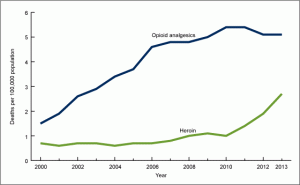Addiction untreated is fatal.

“When people say, ‘if only this family member would just make better decisions’ and they’re referring to an addict, that statement is a misnomer,” describes Greg Schmidli, MSW, Licensed Addictions Counselor, and founder of Turning Point in Denver, “because once the midbrain (a portion of the central nervous system associated with vision, hearing, motor control, sleep/wake, alertness, and temperature regulation) is engaged in drug use, your loved one no longer makes logical decisions. They operate from instinct.”
Schmidli says it’s helpful when looking at addiction as a disease to consider two key points:
1. It’s progressive and gets worse over time. It is fatal.
2. There are identifiable symptoms and stages. With those symptoms you can predict where they are on the scale, but you cannot predict the outcome.
It’s really a lot like diabetes, which is progressive, fatal without treatment, with identifiable symptoms and stages.
For any of you in the middle of dealing with an addict in your life, Schmidli hits very close to home, “where addicts get their power is when they groom their families to make room for the disease in the family. First, they get us to listen to them and believe them, and second, they encourage us not to push back. Because the initial signs are subtle, the addicts help family members explain away their withdrawal from the community and sleeplessness as psychological or shyness or trouble with sleep. Once they groom those in their circle, then the circle grooms others and the web is spread, all because we want to believe the initial lie the addict got us to believe.”
I met Julie Baker in a support group for families and friends of someone with an addiction problem. “Knowing that others have the same struggles,” says Baker, “was such a relief for me. I’d felt so isolated and alone. When I listed to nearly every one in the group talk about their loved one being addicted to heroin, I was floored. I could barely say the word.”
 Support groups throughout the Denver metro area are hosting more people like me and Julie whose family members struggle with heroin addiction. I didn’t know what black tar heroin looked like until I found this piece on my guest room floor. That discovery shifted many things in our family as everything we had wanted to believe until that moment was dashed. Because heroin, especially black tar heroin, is so much cheaper and easier to obtain than prescription drugs, many more young adults are switching to this highly addictive substance with dangerous consequences.
Support groups throughout the Denver metro area are hosting more people like me and Julie whose family members struggle with heroin addiction. I didn’t know what black tar heroin looked like until I found this piece on my guest room floor. That discovery shifted many things in our family as everything we had wanted to believe until that moment was dashed. Because heroin, especially black tar heroin, is so much cheaper and easier to obtain than prescription drugs, many more young adults are switching to this highly addictive substance with dangerous consequences.
Dr. Joseph Shrand, who runs the CASTLE substance abuse treatment program in Massachusetts, says “it looks like there are more heroin addicts in their 20s, 30s, 40s. They think people outgrow it. No. People die. That’s why you don’t have as many 50-year-old heroin users. Because they die.”

Confirming that reality the Centers for Disease Control and Prevention just released a report that finds the number of heroin overdose deaths has tripled since 2013. The office of Drug Strategy, Denver Department of Human Services reports in Colorado that “deaths from heroin overdose doubled from a rate of 1.3 per 100,000 population in 2007 to a rate of 2.6 per 100,000 in 2013.”
Turning Point’s Schmidli says that’s why it’s so critical for families of addicts to:
Set boundaries around behaviors that feed the addiction. That means no more money and no support for them to hang out with those who use.
Not give into the threat: If you don’t do _______ I’ll kill myself. It is true, some loved ones will try to kill themselves, but more will die of an overdose because they continue to use.
Schmidli says “many parents are not willing to risk losing the approval of their child, so when they threaten, the child runs the show. Addicts groom you to fear what they might do to themselves.” And that cycle has no good ending.
Baker said it was hard to recognize how much she’d been enabling her son “because as a mother, I’m a natural caretaker. But I watched my son get older without the ability to take any responsibility for his actions. I did so much to try to help, and nothing I did seemed to make a difference. I finally came to the point of choosing to take care of myself. Once I did that, my life became so much more manageable. I still love my son, and he knows it, but I had to find a way to detach from him and allow him to be responsible for his actions. I support any type of recovery he wants, and I’m fortunate that he’s getting help right now.”
In January of this year, 25-year old Summer Myers of Alaska died of a heroin overdose. Her mother, Jacquelyn Smallwood, told the Alaska Dispatch News “it was a waste of a beautiful life, and a beautiful mind.” In this graphic video, Smallwood says she “wants people to see the graphic photos of her daughter’s body.”
In the Alaska Dispatch News report, Smallwood says she “wants the image of her pretty, raven-haired daughter dead on the floor of a filthy trailer to sear itself into people’s minds. Smallwood realizes this is a strange wish for a mother. But she wants people to be repelled. She wants someone to do what she couldn’t – save their child. Or save themselves.”

Schmidli says there is hope for the addict, when that person makes some key decisions:
- 1. Surrender: stop fighting. Admit you’re powerless over the drug.
- 2. Go through stages of change: these are pre-contemplation, contemplation, preparation, action and maintenance.
- 3. Follow through: the hardest part of making a permanent change is learning how to live life. Many don’t remember how they did this without using.
For those of us trying to support loved ones facing this battle, the challenges are nearly identical. One of the key things I’ve learned in the support I’ve received is that when it comes to your loved one’s addiction, remember the 3 c’s: You Didn’t Cause It, You Can’t Control It, You Can’t Cure It. When I choose to remember this reality, I am a healthier person who has the reserve to love without expectation. Because it’s not up to me.
The American Society of Addiction Medicine describes “addiction to alcohol, drugs, sex, gambling, and more as a brain disorder. Addiction is considered a primary and chronic disorder, meaning it is not the result of stress, abuse, or other causes, and it needs to be treated over a patient’s lifetime, just as one would deal with a chronic disease like diabetes. Addiction professionals and persons in recovery know the hope that is found in recovery. Recovery is available even to persons who may not at first be able to perceive this hope, especially when the focus is on linking the health consequences to the disease of addiction. As in other health conditions, self-management, with mutual support, is very important in recovery from addiction.”
Taking that knowledge seriously is critical for those of us with addicted loved ones. We know there’s hope. And even if it takes a lifetime of learning and changing and support, the bumpy road to recovery is real.
If you’re living through this, you don’t have to deal with it alone. There are a number of 12-step programs out there. Find one that works for you.
lois.melkonian@digital-staging.kdvr.com
[twitter-follow screen_name=’LoisMelkonian’ show_screen_name=’no]